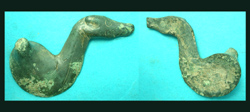Ave!
Olbia, Scythia, AR Stater, Demeter with Sea Eagle reverse, Extremely Rare!
Silver; 24mm/12.7gm Circa 320-315 BC.
Con/ Roughness and oxidation to either side, otherwise, Good Fine.
Obv/ Head of Demeter left, wearing grain ear wreath.
Rev/ Sea eagle standing left, wings spread and head right, on dolphin left; OΛBIO below.
Ref/ Anokhin 287; Karyshkovskij p. 270, 58–76; Frolova & Abramzon 693; SNG BM Black Sea 434 var. (control marks); cf. SNG Pushkin 132; SNG Stancomb 359 var. (same); Sutzu II.
Seller's Note/ Oh dear, or dear, whatever happened to this issue to cause such surface damage? Too many ages resting in highly acidic soil? Over-striking, perhaps? Both? Either way, it remains Extremely Rare.
For price referencing, the coin seen below sold at auction for $12,000!
FYI - Circa 331-328 BC, Alexander the Great’s satrap of Thrace, Zopyrion, led an expedition of about 30,000 men across the Danube, into Scythia. He soon besieged the city of Olbia, which put up a staunch resistance. Olbia took drastic measures in its attempt to bolster it position militarily and economically: slaves were freed, foreigners were granted citizenship, and debts were canceled. While these measures proved to be beneficial, the success of Olbia surely was helped by a winter storm that decimated the Macedonian fleet that must have played a significant role in Zopyrion’s strategy. Ultimately, the siege was raised, and the Macedonians were forced to march back to Thrace. Along the way, the already weary army was picked apart by Scythian raiders and a brutal winter. It is unknown how many made it back across the Danube, but Zopyrion was not one of them; he died en route, either at the hands of the Scythian's or as a result of the harsh conditions, circa 325/4 BC.
Although victorious, Olbia certainly was not unscathed by the siege. During the event, Olbia struck a siege coinage (cf. Anokhin 274–6), which showed its desperate position. However, the city’s coinage over the subsequent decades attest to a city not in decline, but ascendant. By 315 BC, the city redeveloped its economy, which is reflected by a robust precious metal coinage in multiple denominations, including both silver and gold.





